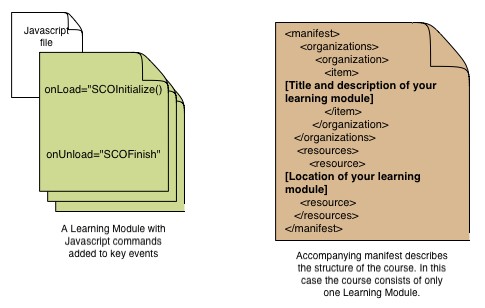SCORM in 5 minutes or less, with pictures!
Disclaimer: This is intended only to provide only the most basic understanding of what SCORM is.
SCORM (Shareable Content Object Reference Model) is a world-wide standard set of specifications for communication between elearning content and learning management systems.
A learning module using SCORM version 1.2 can communicate the following:
- the instruction to launch an elearning module and start communicating.
- scoring and tracking information – student data, timing, lesson status, scores, interactions, “pass/fail”
- proprietary information that only the module understands. The Learning Management System (LMS) stores and retrieves such data without understanding it.
- bookmarking information
- the instruction to close communication.
Additionally, a manifest packaged with the module tells the LMS (Learning Management System)
- what, if any, modules come next.
Examples of messages conveyed by SCORM communication:
A SCORM-compliant learning module sends its data via client-side javascript to an “API Adapter” which relays it on to the LMS.
The API Adapter translates and relays commands to the LMS.

An API adapter is simply a Java or flash object sitting somewhere in the browser window, often in a hidden frame. You can think of it as a translator between Javascript and whatever language the LMS understands.
What are the minimum ingredients of a SCORM-compliant module?
Learning Module and Manifest = minimum package
To create the simplest SCORM-compliant module, commands are added to key events in the module, such as when the page opens and closes, which tell the LMS to open or close a communication session, and to set the status of the lesson correctly.
The LMS must have some way of knowing the structure of the course, and where to find the different pieces, so a “manifest” must be created for EVERY SCORM course. This is simply an xml file which details the course structure and which resources are associated with each piece of the structure.
That’s the basic idea behind SCORM: a common language that all LMS’s and learning modules can use, so that modules can be shared and packaged in different ways. The key word is MODULAR! The same module can be used by itself or in combination with other modules, so there really should be no reference WITHIN a module to external modules that could change.


Do you provide any template resources S1000D or Simplified Technical English standards compliance? Thanks.
An other great ressource on SCORM with nice flash animations and “non-SCORM users” images is propose by the SCORM School 101 provide by the Academic ADL Co-Lab (http://www.academiccolab.org/scormschool/101).
The firsts sections are also more interesting for an introduction to SCORM then the last one.
Not to take a 5 minutes tour, but maybe an hour of the SCORM basics elements.
Have a nice day!
JF
—–